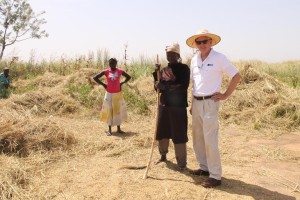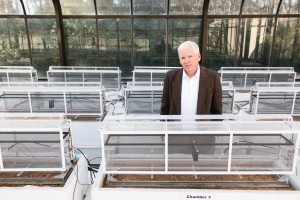The Scott Angle Perspective

Scott Angle became President and CEO of IFDC in 2015 following the retirement of Amit Roy.
The small town of Muscle Shoals, Alabama, is famous in the United States as the home of a recording studio that has seen music royalty record songs that have entertained millions. Those outside the U.S. know another institution that hails from that town, one that has helped feed millions around the world — the International Fertilizer Development Center (IFDC).
Dr. J. Scott Angle was named President and CEO of the 41-year-old organization in October 2015 following the departure of Amit Roy. Given Angle’s history, the new role seems a fitting one.
Angle, a former Fulbright scholar, has worked as a soil scientist at the University of Georgia, where he also served as dean of agriculture. The department’s quarter of a billion dollar budget and 2,300 employees also helped prepare Angle for the position at IFDC. And during his career as a soil scientist, Angle spent time working in other countries, particularly on the continent of Africa, a main focus for IFDC.
“A lot of things came together — my scientific expertise, my administrative background, and my interest in Africa,” he says. “Frankly, there probably aren’t that many people in the country or world where those three areas all come together.
“If you work in soils and you’re in Africa, you know about IFDC. They’re a major player in many countries. It was something that I’ve been familiar with for decades.”
And now that familiarity turns to intimacy.
While treating soils with fertilizer remains an important activity, IFDC has expanded its role over the years.
“When it first started, it was all about using fertilizers appropriately to increase crop yield,” Angle says. “Over time we learned that is not enough. If you increase crop yields with no place to sell your (products), why do it? It’s a waste of time, effort and money. We’ve evolved into an organization that looks at the entire value chain — from those inputs needed to maximize productivity, all the way to making sure that the farmers have a place to sell their products and that they’re getting a fair price for it.”
That means the IFDC’s mission requires it to deal with more than just helping growers. The organization develops entire markets, and that takes involvement from players at several levels, including government.

Scott Angle spent much of his early tenure touring IFDC facilities in Africa. Here he visits with farmers in Ghana.
“IFDC is very good at helping farmers increase yields; that’s our primary mission,” Angle says. “But if you increase yields to the point where there is no market to absorb those additional products — if you double, or triple or quadruple yields, and you don’t have a place to sell it, then it’s been a huge waste of time and effort.
“IFDC spends a lot of time on the back end of the proposition of helping these farmers develop mechanisms to sell their excess produce, food, and feed. There are lots of ways that this has been done. It’s been a major focus. There are millions of farmers around the world who have benefited from IFDC’s focus on building these markets.
“Something less than a decade is typically needed to build up a supply chain — five or six years is average to the point where we would be comfortable that the survivability of the chain IFDC has helped create will be around long after IFDC is gone,” Angle says.
That supply chain covers everything from growers learning how to use fertilizer properly to developing government policy or economic strategy.
“IFDC works around the world, not just in Africa, though about 85% of the organization’s work is done on that continent,” Angle says. “There’s a relatively strong group in South Asia as well. There the questions are very different. Fertilizer is not limited in countries like Laos, Cambodia, Thailand, Myanmar, and, in fact, in some cases they’re using too much fertilizer because it is subsidized. It’s so cheap.”
Farmers, like many homeowners, believe that if “X” amount fertilizer is good then 2X must be twice as good.
“When you’re not really paying much for the fertilizer, you don’t worry about the economic impact of the fertilizer that you’re using.”
Because it does work in so many countries around the world, IFDC must be able to adapt to the local conditions.
The questions are very different. If it’s not fertilizer, it might be water pollution or climate change. “And then you get into all the policy issues — are these subsidies working, are they distorting the markets?
“We’ve got boots on the ground in each one of these countries,” Angle says. That’s one of the great strengths of IFDC. We’ve got good understanding of the local culture, the local economy, what works, what doesn’t.
“It’s pretty hard to sit in Muscle Shoals or Washington D.C. and talk about what a farmer needs in a small village in Ghana. Much of what they do is going to be limited, constrained, or promoted based on local education, local needs, local availability of resources. We’ve got the people on the ground who can understand what those constraints are and then take the best technologies available and adapt it to the local situation.
“That, ultimately, is IFDC’s greatest strength — we’re good scientists, we’re good economists, we’re good educators, but it is having those people on the ground who understand what life is like in that village, what works and what doesn’t work.”
While each country, each community has its own issues, the ultimate goal is the same.
“Just about every country that I’m familiar with understands that producing more food, becoming closer to self-sufficiency in food production is important for lots of reasons — politically, economically,” Angle says. It’s just the right thing to do for the country. There’s a real focus, now, on each of these countries wanting to produce more food.
“They understand fertilizers are probably the most important factors limiting production right now.
 Focus of Africa
Focus of Africa
IFDC has operations in more than 20 countries around the world, but the bulk of the organization’s efforts are clearly focused on Africa.
“In agriculture, everyone is looking to Africa,” Angle says. “That’s where our need and our goal to feed a hungry world will either be made or broken. There are many areas of the world that simply aren’t going to be able to produce a lot more food. A lot of areas, it’s just too cold. Sunlight drives agriculture and if you’re in northern Russia or the northern Great Plains of the U.S. or Canada, there’s not enough sunlight, not enough growing days to really drive agricultural productivity much harder than it is right now.”
Growers’ yields on that continent are far below what most of the rest of the world sees. While there are several reasons for that one of the major factors is that African growers on average only use about 10% of the fertilizer that is needed to produce average yields seen around the rest of the world.
“There’s lots of information showing that about half of all the food produced on the planet today is directly attributed to fertilizers that are applied to the soils,” Angle says. “The leap that we make from that point is that in Africa, because they’re only using 10% of what we’d call the recommended rate of fertilizer for those countries, yields are much, much lower than they need to be, particularly much lower than they need to be as the population grows and demands higher quality food.”
Challenges
Working in countries around the world, particularly in places where there is political instability, can sometimes require IFDC to pull its staff until the situation calms down. And while he won’t say where, the organization is keeping an eye on one country while working on an evacuation plan.
“We hope they don’t (need to use it), but you never know,” Angle says. “We’ve had to pick up literally overnight on occasions and get out and sometimes stay out a year or two before we can get back in and start doing the good work of the organization. Local politics is always an issue.”
Of course, not all the obstacles are that extreme.
“We face challenges with trying to help people understand the importance of fertilizers,” Angle says. “There are plenty of people who group chemicals all into one big category. It doesn’t really matter what it is. We have to be able to parse out those important materials to enhance productivity from those that can be a problem.”
The key to overcoming any of its challenges is what IFDC does best — education.
“IFDC is one of the leading fertilizer organizations and is at the forefront of the educational process,” Angle says.
Looking to the Future
As the organization’s leader, part of Angle’s role is to chart how IFDC will evolve.
“As I look over the next ten years, at least, climate change is going to be a big part of it,” he says. “The buzz word these days, and IFDC is right in the heart of it, is ‘climate smart agriculture’ — making sure agriculture is managed in a way that reduces the impact, to the maximum extent possible, on the environment. That’s really going to drive what we’re going to do in the future. We’re going to get into more complex fertilizers. The days of just N, P, and K, without some of these other added elements as we understand their impact on yield, but particularly human health, it’s going to cause the industry to change a little bit, too.
“We generally stay out of the climate change debate, acknowledge that it’s happening, but don’t get into who is causing it. We leave that for other people to debate. We help farmers adapt to the changes that are occurring. It’s very obvious in many areas of the world. Agriculture is going to be affected both positively and negatively by it. It’s climate change — there are all kinds of different effects over the last couple of decades that we fully expect to continue. IFDC has been working with farmers, particularly in Asia, where a lot of climate change seems to be happening most quickly. We’re helping farmers there adapt to some of these changes. We also have the obligation, at least from the fertilizer perspective, that future fertilizers, how they’re applied, how they’re managed have a minimal impact on the climate.”
IFDC is also exploring the positive impact agriculture can have on climate change by sequestering carbon in the soil. “One of the best ways of reducing carbon dioxide in the atmosphere is to tie up that carbon in the root biomass of plants and hold it there as organic matter.”
Innovation
For IFDC teaching farmers how to increase their yields and developing the markets for those increased crops isn’t enough. The organization also develops new tools for those farmers.
“IFDC, a number of years ago, developed a technology called fertilizer deep placement/urea deep placement,” Angle says. “That’s where growers take a small briquette of urea and bury it in the soil rather than broadcasting on the surface.”
The traditional broadcast method results in much of the nitrogen ending up in the atmosphere where it gets implicated in greenhouse gas and climate change problems.
“Farmers can lose well over half of what they’ve applied to the soil to the atmosphere. Because of that, they have to apply more fertilizer. This technology has significant environmental benefits by placing the briquettes six inches into the soil around the root zone.
The fertilizer deep placement program has climate change implications and allows farmers to use less fertilizer. They save money, and the yields go up because there’s more fertilizer available. It’s meted out during the course of the growing season. It’s been particularly successful in the rice growing nation of Bangladesh.
“In some cases, 30% less fertilizer is being used under these conditions,” Angle says. “It’s fundamentally changed rice production in Bangladesh, and it’s being used all over Asia. We’re trying to incorporate it as much as possible in Africa as well.”
Success Stories
Developing Markets
IFDC has helped almost a quarter million farmers in lots of countries organize themselves into something akin to small and medium-sized businesses that are then able to pool the extra food produced.
“Farmers can come together to demand a higher price for what they are producing,” Angle says. “It’s had tremendous impact on individual farmers’ profitability. It has allowed businesses to develop along that value-added supply chain. Countries that have worked with this have been very pleased.”
2SCALE
“Our 2SCALE project also has a requirement that the private sector be involved — essentially they match any donor money that is supplied,” Angle says. “Both international and local companies have been thrilled with this project because it allows them to have something that will exist once the 2SCALE project is finished and we’ve walked away. It isn’t just us giving food, giving technology, giving knowledge. It’s giving an infrastructure that will survive once all the donors are gone from the project.”
Fertilizer Deep Placement
This program began about 20 years ago with an understanding that burying the nitrogen in the soil would reduce nutrient losses to the atmosphere and to water and allow farmers to use less nitrogen. While the concept was good, it couldn’t be turned into a reality without the invention of an applicator.
IFDC got some university help and created the tool that made the program a success.
“It was a huge change for rice farmers in Bangladesh 10 years ago,” Angle says “That change is going on in Africa literally as we speak.
“Going from the way they’ve grown rice for decades to hundreds of years to something that is much more defined and scientific is a big change. There’s lots of education. We had to be able to demonstrate that it works first. Farmers are skeptical by nature, whether it’s a farmer in the U.S. or a small village in Africa, they’re not going to believe it until they see it.
“Income on a per hectare basis has gone up about $220 a hectare (in Bangladesh) just because of this technology.”






